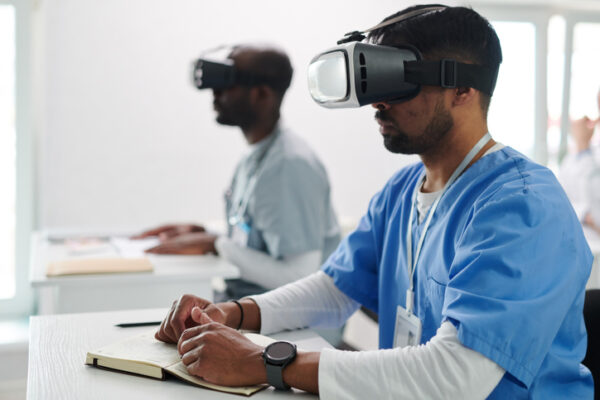
I often speak about the usefulness of simulation in nurse training, highlighting how virtual reality (VR) technology has expanded the menu of simulation options beyond manikins and standardized patient actors. A new study in Taiwan even advocated that VR simulations “should be arranged as early as possible in fundamentals of nursing practice courses” due to their value in teaching soft skills, such as therapeutic communication, through practice scenarios.
However, from my conversations with nursing administrators and instructors, I know there are some lingering misconceptions around the use of VR that might give instructors pause before deciding to add a VR component to the nursing curriculum.
1. Doesn’t VR require a large space?

With the Rise of AI, What IP Disputes in Healthcare Are Likely to Emerge?
Munck Wilson Mandala Partner Greg Howison shared his perspective on some of the legal ramifications around AI, IP, connected devices and the data they generate, in response to emailed questions.
A major advantage of VR as a training modality is its flexibility, as it can be used in the lab, the classroom, or even from home for nurse learners who live long distances from the training center. Since VR replaces visual reality with a virtual one, the learner needs a clear safe space when donning the headset to avoid mishaps when losing track of physical surroundings. A rule of thumb is to allocate approximately 7ft by 7ft of free space per user to ensure a comfortable experience. Compared to other simulation types, though, VR requires little re-set time or sanitation procedures.
2. Won’t VR require a network systems upgrade?
Because of the immersive nature of VR, a VR headset — even untethered — is best used in a static space to avoid physical hazards. Wireless network challenges such as bandwidth, latency, and consistency are considerations as internet speeds vary based on location and connection (cable, DSL, fiber, 5G wireless, etc.). However, if an internet connection is good enough for smooth video streaming, it should be adequate for VR, although more bandwidth will be required if there are multiple learners. If the area for using VR does not have good WiFi speed or reliability, it may require an upgrade to a newer router or mesh router system, or adding a range extender. As with configuring space requirements, it’s wise to consult an expert in VR simulation to ensure you get the best network setup.
3. Won’t VR learners be isolated from classmates?
Immersive VR convinces the mind to feel a sense of true physical presence in simulated scenarios, encouraging deep focus while interacting with patients and team members. Younger, “Gen Z” nurses especially value collaboration and are more likely to thrive in environments where they can engage with their colleagues. A 2022 Cairo University study found “a statistically significant positive correlation between nurse collaboration behavior and quality of work life.” Depending upon the VR platform, training can be delivered in a variety of flexible instructional approaches. Training can be facilitated by instructors, or through peer-to-peer interactions, where multiple active participants have the capability to exchange objects and share information directly. Additionally, this flexibility extends to observational learning, with peers able to watch the simulation unfold either on their computers or from within the VR environment itself. Learners can also participate from different physical locations, an advantage for nursing educational institutions drawing nurses from remote rural areas.
4. Doesn’t VR make people sick?
VR-induced sickness is not common, but it is real. It’s essential to use a VR platform with high frame rates and accurate proprioception so that your brain and body movements feel connected. Personally, my triggers are similar to those for car sickness — if I haven’t eaten lunch, if I’m not well hydrated, if I don’t have enough fresh air. Nausea and headache are correlated to VR exposure time, so it’s best to take a break after 30 minutes in a headset. If learners feel discomfort, they should be able to participate by actively observing a casted view of the VR simulation on a TV or computer screen.
5. Isn’t VR only appropriate for large nursing schools with deep pockets?
According to a UK study, VR allows “simulations to be delivered at reduced cost with fewer resources,” especially relevant for institutions looking to scale training. Virtual experiences help reduce the material costs of nurse education as there’s no need to purchase new medical equipment or supplies for each nurse to train on, also saving on medical waste. VR headsets such as Meta Quest, HP Reverb, and ByteDance Pico can be had today for as little as a few hundred dollars, depending on the version. (Perhaps by the time nursing applications have been developed for the eye-wateringly expensive new Apple Vision Pro, the pricing will have adjusted to a more accessible level.)
An urgent need
The website of the American Association of Colleges of Nursing (AACN) tallies sobering statistics that highlight a concerning trend. Despite projected growth in the nursing workforce according to the Bureau of Labor Statistics’ Employment Projections, the continued shortage of qualified nurses, nursing instructors, preceptors, and clinical placements is real. And it will only worsen as the tail end of the Baby Boomer generation hits retirement and increases long-term care needs.
Incorporating VR-based training simulations into the nursing curricula presents a practical solution to instructor and clinical placement shortfall. If instructors can navigate past their apprehensions toward the unfamiliar, VR can help in ushering more qualified nurses through the pipeline, more quickly, to avoid a healthcare deficit that could compromise the quality of patient care.
Photo: shironosov, Getty Images
Christine Vogel, MSN, RN, CHSE, CHSOS, is a lead nurse educator at UbiSim , where her passion for innovation in nursing education drives her to design, pilot, and evaluate evidence-based immersive virtual reality (VR) simulations for nurse learners. With a distinguished career that extends over 25 years in nursing, including more than a decade dedicated to academic roles, her work is inspired by a commitment to enhance the educational journey of nurse learners and improve patient care.














